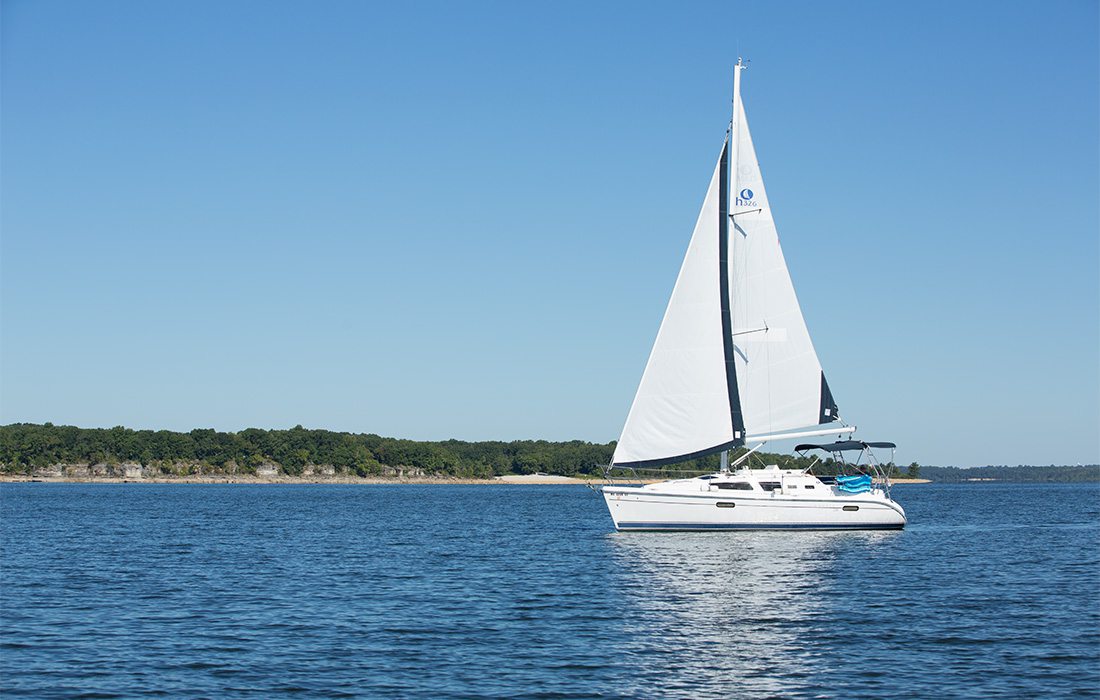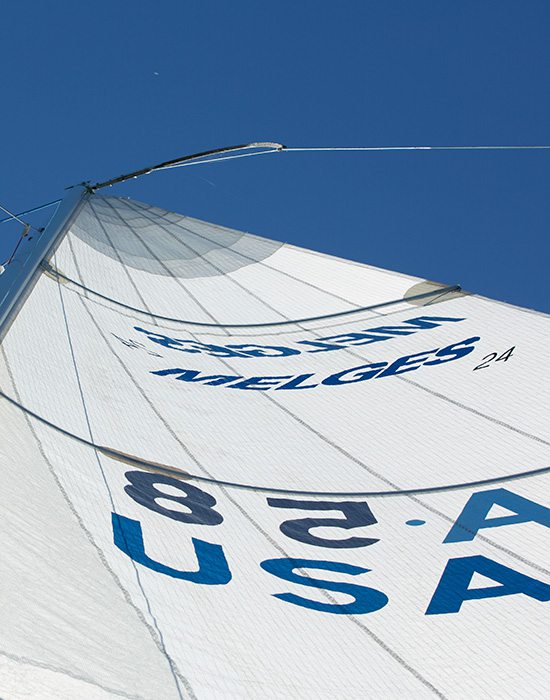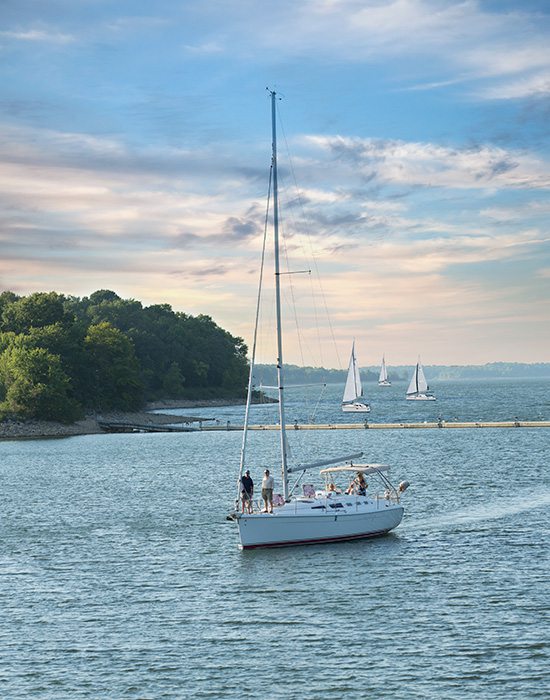Sailboats get speed from winds that hits the sails, so lifting and directing sails is crucial.
Outdoors
Sailing with the Lake Stockton Yacht Club
Ahead of the Governor’s Cup, we spent time out on the lake to get an inside look at the members of the Lake Stockton Yacht Club and a peek into what life is like at the helm.
By Evan Greenberg
Sep 2018

The drive to Orleans Trail Marina at Stockton Lake is a series of hills and sharp bank turns where the natural inclination is to drive about 10 mph slower than usual just to be safe. After a few more left and right turns, water and sailboats appear out of nowhere. It’s the closest you can get to beaming through a portal, the Ozarks’ answer to the sensory overload that comes with stepping out of a subway station as a hulking mass of city envelops everything around it. The boats, majestic vessels of blues and reds, are the main attraction, stuck in place until they aren’t. It’s here that the Lake Stockton Yacht Club convenes as often as it can. For some, it’s a means of escape. For others, it’s a way of life, something they’ve done for as long as they can remember. And for the sharpest of them all, it’s the site for the largest sailing regatta in Missouri, the Governor’s Cup, which will have its 44th running in mid-September.
Sailing is unforgiving, completely dependent on the elements of any given day, demanding diligence and snap decision making. There’s a specific type of person who excels at it, and Stockton Lake is full of them. If the Earth is 70 percent water, why shouldn’t it be the place we spend the majority of our time, racing and cruising and losing track of time? Those who sail on Stockton Lake have this figured out. For them, the lake is a repository of joy, grief, craftsmanship and memories, an equal playing field devoid of discrimination, where the only things that matter are mastery and a willingness to completely give yourself in to the matter at hand.
Intro to Sailing 101
The first time I sail in early May, I mention to some of the club members that I’m working on this story, and they all look a bit panicked. Stockton Lake, they tell me, has the perfect conditions for sailing, with its steady breeze and wide stretches. It’s a hidden gem that they’d like to keep for themselves.
I’m set to race on Bob Malouff’s Cinnamon Girl, and our opponents compete on other wonderfully named vessels like Sweet Baby J and Hoof Hearted. The most striking sailboat, Old Glory, is owned by Sam Jones, who’s owned the boat since 2001. Once a candidate for attorney general of Missouri, Jones wears a Mickey Mouse watch and has hats and shirts embroidered with his boat’s name on them—he did this with an old boat he had in Oklahoma, too. I can’t fault him, either—Old Glory really is a sight to behold. While out on the water, I snap a photo of it, and it becomes my phone lock screen.
Malouff puts me to work in the pit position, where, for a lack of an eloquent phrase, I’m in charge of pulling on a line—please don’t call it a rope—really fast. In more scientific terms, I assist in raising the sails up and down. I enjoy being useful—as far as I know, the whole operation would fail without me, and I choose to believe this. Throughout the day, each of my crew members refers to me as “Aaron,” which is decidedly not my name. But I don’t mind. Aaron is my sailing name now.
What strikes me most about sailing is just how violent it is. A sailboat is no place for a deft touch. From race to race, the routine is the same; it’s all a bit circuitous. It’s also binary; you’re either doing it or you’re waiting to do it. The moments leading up to the beginning of a race feel as though they should be accompanied by an orchestra stuck in a permanent upward crescendo, the conductor flailing and oboists and violinists feverishly attacking their instruments. There are judgment calls to make: When should you execute a certain maneuver? Who does what task? And for how long? Close your eyes and the sounds and commands you hear might place you in a factory—all the more striking given the white collar context in which sailing is often placed. This is a mechanical process; there aren’t really different interpretations of how to do a certain thing. And you either do that thing exactly when it needs to be done—with authority and conviction, please—or not at all.
There is something inherently analog about a sailboat, too, about the act of sailing itself. The way it’s done is the same now as it was at any other point in history. At any given time, a myriad of pulleys and lines and man and machine work together to try to outsmart the opponent and the elements. There’s water—the travel vessel. There’s wind, both enemy, friend and the only way to get from Point A to Point B; it’s also actively trying to prevent you from doing so. Sailing requires an understanding of a sailboat’s mechanics, something that doesn’t just happen overnight. If ever there were an answer to the “When will we ever have to know this” question often posed in early-schooling science classes, this is it.
This particular day is Cinco de Mayo, and after I sail, I’m invited to a party to celebrate. Upon arriving, I’m told that I have to meet The Mayor, one of the organizers of any and all festivities. Several people regale me with tales of Todd McQueen, recounting parties late into the night on his E-Dock. When we meet, he immediately starts cracking jokes—upon identifying myself as a reporter, he asks me if I’m from Playboy. I am not. McQueen has graying facial hair and his beer koozie reads “Pirates Drinking Team.” He’s been coming to Stockton Lake since he was 15—he likes the peace and tranquility the lake offers. He’s not a racer; he’d lose his love for it and it’d turn into work if he were. He got his nickname on a lark when he was moving chairs one day and one of his dockmates razzed him. “What are you, the mayor of E-Dock?” Another of his dockmates concurred, and the name has stuck since. We chat some more, and I eat some chips and dip before as my day ends.


Stockton Lake is a premier sailing spot thanks to its winds and open waterways.
Race Committee
The next time I come to the lake, it’s June. I want to get a 360-degree view of everything, so I join Jim McCraw on race committee, where we’ll be charting checkpoint and finishing times of all the boats. McCraw has a self-described “fu-manchu” mustache. It occurs to me that if “share three interesting things about yourself” were a contest, McCraw would win running away. He gets to the lake as often as he can, weekdays often included. He spends Valentine’s Day with his wife, Linda, on his boat, Wasting Time, bringing candles and flowers and DVDs. Linda is the boat’s admiral, a common term among sailors to indicate who calls the shots. McCraw’s family owns a 200-year-old farm that his nephew now runs. It’s been in his family for generations—he used to be a dairy farmer during the Carter administration, but a drought in 1980 put him out of business. His great-great grandfather was a surveyor for the lower third of Missouri, which was mostly forest at the time. He has a love for British cars, borne out of a desire to be different; now he’s turned it into a passion, helping found a club in 1999 and organizing monthly rides and an annual car show in Carthage.
McCraw is drawn to sailing for its solitary nature and the mental acuity it requires. “You gotta be self-sufficient,” he says. “If something breaks, generally you fix it yourself.” His boat, with its intricate wirings and DVD capabilities and every last detail accounted for, should have MTV’s attention. “Just like people drive cars, a lot of them don’t know anything about the car,” McCraw says. “I’d say 25 percent of us do work on our own stuff, the other 25 percent know absolutely nothing about the boat, the other 50 percent are somewhere in between.”
It’s not a particularly windy day, which is more or less a death sentence for a day on the lake. At one point in the middle of the afternoon McCraw and I look on as a few of the boats come to a standstill. Sailing is a sport that doesn’t hide its metaphors, and it’s here that all the times water is used as a parable in literature start to make more sense to me. At one point, Mother Nature lays it on thick as it starts to rain. But there’s no tarp or rain delays and we all soldier on until it stops. I am now an expert at using a stopwatch and writing numbers down, and I get thanked a few times for helping. Though it’s not strenuous work, I feel accomplished, having weathered the elements to deliver accurate results.
A Lasting Passion
Paul Nahon is among the best racers at the club, winner of 14 Governor’s Cups, and about as good an ambassador for the sport as you’ll find. He looks a bit like a newsman—well-coiffed hair and a deep, confident baritone. When he’s not sailing, he’s busy winning tennis championships as General Manager of the Springfield Lasers, a World TeamTennis team. But the lake is where Nahon is most himself, operating around the boat with a calculated nimbleness. He is naturally enthusiastic, and he loves that you’re enthusiastic too.
Nahon has been with the club for 26 years, throughout its several transformations and leadership changes and driving to the lake on the weekends as much as possible. When he was around 7 years old, he read By the Great Horn Spoon!, and it spoke to him. “I was trying to read all these books and I read it and it talked about sailing around the cape of South America and when I read that it kind of intrigued me,” he says. In his sophomore year of college at Southwest Missouri State, now Missouri State, he fell in love twice. First, with his now-wife, Angel. They met at a gas station when his sister, a friend of hers at the time, introduced them. It was then, too, that Nahon broke his wrist playing tennis right before nationals. With the time he couldn’t use with a racket, he took up sailing. Love struck again.
“I sailed all summer,” Nahon says. “And it was windy all summer. So my buddy—he was a Jimmy Buffett-type guy—and I sailed the whole summer and that’s where I kind of got to the point where he said, “Ok, you can take my boat any time.”
Nahon moved to California after school, and really got into racing at Manhattan Beach, where he discovered he liked the teamwork aspect of working with a crew in unison. It was a contrast to the often lonely nature of tennis, and he took to it.
The water is the backdrop of Nahon’s best stories, like the time he chartered a boat to Mexico while living in California selling boats. On the way back, he and his crew got caught up in a storm, traversing through violent winds before arriving in San Diego, dehydrated and beat up. They sailed to the wrong customs and were told that they were in violation of international law. They were let off, sailed to the right customs, and counted their blessings.
Angel tells me that sailing “fulfills” her husband, that it fuels his competitive nature. She doesn’t go out on the boat much, but she does put her background as an art teacher to good use, painting from pictures she’s taken while sitting on the dock. People ask her why she allows her husband to disappear on the weekends, and she’s baffled by the question. “He’s happy doing what he’s doing—I’m happy for him,’” she says.
When his son Paul Nahon III passed away in 2013, Paul was overcome with grief. Just 20 years old, he was an accomplished tennis player who won two state tennis titles in 2010 and 2011. Paul woke up and cried every day, feeling nothing but loss. He tried distracting himself with tennis, but it didn’t give him the respite he craved. So he turned to sailing.
“In tennis and other things that distracted me, I was almost being physically abusive to myself,” Nahon says. “Not in a bad way, but pushing myself too hard because I had this anger, and sailing seemed, that didn’t bring that out of me. [Paul] was my buddy for ten years out on the tennis court, so that was painful, whereas sailing was completely different.”
One month after his son’s death, Nahon won the Governor’s Cup. He realized in that moment how much sailing meant to him, that even in his darkest hour, there was something he loved so much that, if only for a few fleeting hours, he could forget. He could forget about the immense loss that clouded him and retreat to his place of refuge on the water.
There’s a certain catharsis that can only be found in the things we are most passionate about—having something that provides an escape from the cacophony of noise that permeates everyday life. The backdrops are innumerable—for the members of the Lake Stockton Yacht Club, that place just happens to be the water. It’s where time slows down and instinct takes over.
“When I get out there, every component of [sailing] is a getaway,” Nahon says. “And when I get away, every component of it is relaxing, even though it’s crazy out there, everything slows down. And it takes your mind away from everything. You don’t have anything to think about but executing the wind and every component of it. To me it’s like meditation. I’d do it every day if I could.”
Sailing for Supremacy
The Governor’s Cup is held September 14–16 at Stockton Lake.












